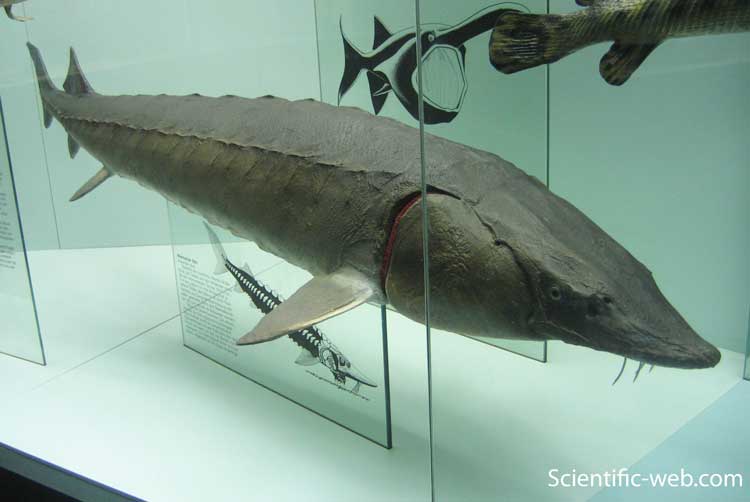
Acipenser sturio , Photo: Michael Lahanas
Superregnum : Eukaryota
Regnum: Animalia
Subregnum: Eumetazoa
Cladus: Bilateria
Cladus: Nephrozoa
Superphylum: Deuterostomia
Phylum: Chordata
Cladus: Craniata
Subphylum: Vertebrata
Infraphylum: Gnathostomata
Megaclassis: Osteichthyes
Superclassis/Classis: Actinopterygii
Classis/Subclassis: Actinopteri
Subclassis/Infraclassis: Chondrostei
Ordo: Acipenseriformes
Familia: Acipenseridae
Subfamilia: Acipenserinae
Genus: Acipenser
Species: Acipenser sturio
Name
Acipenser sturio Linnaeus, 1758
Neotype: MNHN 1962-1295.
Paralectotypes: BMNH 1853.11.12.210 (1); NRM 94 (1), 21711 (1).
Type locality: Charente River at Saintes, France.
Etymology: the name sturio is Latin for sturgeon.
References
Chassaing, O., Desse-Berset, N., Hänni, C., Hughes, S. & Berrebi, P., 2015: Phylogeography of the European sturgeon (Acipenser sturio): A critically endangered species. Molecular Phylogenetics and Evolution, Available online 28 September 2015. DOI: 10.1016/j.ympev.2015.09.020
Linnaeus, C. 1758. Systema Naturae per regna tria naturæ, secundum classes, ordines, genera, species, cum characteribus, differentiis, synonymis, locis, Tomus I. Editio decima, reformata. Holmiæ: impensis direct. Laurentii Salvii. i–ii, 1–824 pp DOI: 10.5962/bhl.title.542: 237. Reference page.
Links
Acipenser sturio in Catalog of Fishes, Eschmeyer, W.N., Fricke, R. & van der Laan, R. (eds.) 2022. Catalog of Fishes electronic version.
Acipenser sturio in FishBase,
Froese, R. & Pauly, D. (eds.) 2022. FishBase. World Wide Web electronic publication, www.fishbase.org, version 08/2021.
IUCN: Acipenser sturio Linnaeus, 1758 (Critically Endangered)
[1] Listed animal in CITES Appendix I
Acipenser sturio in the World Register of Marine Species
Vernacular names
azərbaycanca: Atlantik nərəsi
български: Атлантическа есетра
brezhoneg: Sturj
català: Esturió comú
čeština: Jeseter velký
Deutsch: Europäischer Stör
English: European sturgeon, Atlantic sturgeon, Baltic sturgeon
español: Esturión Común
eesti: Atlandi tuur, Tuur, Läänetuur
euskara: Gaizkata arrunt
suomi: Sampi
français: Esturgeon d'Europe
עברית: חדקן אירופאי
magyar: Közönséges tok
italiano: Storione europeo, Storione baltico
日本語: バルチックチョウザメ
lietuvių: Sturys
Nederlands: Oost-Atlantische steur
norsk: Alminnelig stør
polski: Jesiotr zachodni
português: Solho
русский: Атлантический осётр
slovenčina: Jeseter veľký
српски / srpski: Acipenser sturio
svenska: Europeisk stör
ไทย: ปลาสเตอร์เจียนยุโรป
Türkçe: Kolan baligi
українська: Осетер європейський
Tiếng Việt: Cá tầm thông thường
中文: 歐洲鱘
The European sea sturgeon (Acipenser sturio), also known as the Atlantic sturgeon or common sturgeon, is a species of sturgeon endemic to France. It was formerly abundant, being found in coastal habitats all over Europe. It is anadromous and breeds in rivers. It is currently a critically endangered species.[1] Although the name Baltic sturgeon sometimes has been used, it has now been established that sturgeon of the Baltic region are A. oxyrinchus, a species otherwise restricted to the Atlantic coast of North America.[5]
Description
Head of a European sea sturgeon
Newly-hatched larva
The wedge-shaped head of the European sea sturgeon ends in a long point. There are many sensitive barbels on the facial area. The dorsal fins are located very far back on the body. Five longitudinal lines of large osseous plates are found on the body of the fish. The stomach is yellow and the back is a brownish grey.
This sturgeon can reach 6 m (20 ft) and 400 kg (880 lb) in weight, but a more common length is 1.25 m (4 ft 1 in).[6] They can reach an age of 100 years,[6] and have a late sexual maturity (12 to 14 years for the males and 16 to 18 years for the females).
Distribution and habitat
They are found on the coasts of Europe, except in the northernmost regions and the Baltic region, and have rarely even been known to cross the Atlantic Ocean to the coasts of North America. Like many other sturgeons, they spawn in the rivers inland from the coast.
Conservation
At the beginning of the 19th century, these fish were used extensively to produce caviar, but have been a protected species in Europe since 1982. Despite their estimated range of distribution, they have become so rare that they only breed in the Garonne river basin in France.[7] Conservation projects involving this species include reintroductions based on specimens from aquaculture with the first releases in 1995.[1] For example, 87 sturgeons were experimentally released in the Rhine near Nijmegen in 2012 and 2015.
Diet
Like other sturgeons, they eat mollusks and crustaceans which they find with their barbels.[
References
Gesner, J.; Williot, P.; Rochard, E.; Freyhof, J.; Kottelat, M. (2010). "Acipenser sturio". IUCN Red List of Threatened Species. 2010: e.T230A13040963. doi:10.2305/IUCN.UK.2010-1.RLTS.T230A13040963.en. Retrieved 19 November 2021.
"Appendices | CITES". cites.org. Retrieved 2022-01-14.
Froese, R.; Pauly, D. (2017). "Acipenseridae". FishBase version (02/2017). Retrieved 18 May 2017.
"Acipenseridae" (PDF). Deeplyfish- fishes of the world. Retrieved 18 May 2017.
Ludwig, A; Arndt, U; Lippold, S; Benecke, N; Debus, L; King, T. L.; Matsumura, S (2008). "Tracing the first steps of American sturgeon pioneers in Europe". BMC Evolutionary Biology. 8: 221. doi:10.1186/1471-2148-8-221. PMC 2527320. PMID 18664258.
Froese, Rainer; Pauly, Daniel (eds.) (2005). "Acipenser sturio" in FishBase. 10 2005 version.
"Protection of common sturgeon: advice for fishermen". gov.uk. January 16, 2017.
"Acipenser sturio". Integrated Taxonomic Information System. Retrieved 11 March 2006.
Burnie, David, ed. (2001), "European sturgeon", Animal, Dorling Kindersly, p. 481
Retrieved from "http://en.wikipedia.org/"
All text is available under the terms of the GNU Free Documentation License

